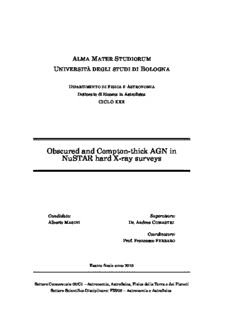
Obscured and Compton-thick AGN in NuSTAR hard X-ray surveys PDF
Preview Obscured and Compton-thick AGN in NuSTAR hard X-ray surveys
ALMA MATER STUDIORUM UNIVERSITÀ DEGLI STUDI DI BOLOGNA DIPARTIMENTO DI FISICA E ASTRONOMIA Dottorato di Ricerca in Astrofisica CICLO XXX Obscured and Compton-thick AGN in NuSTAR hard X-ray surveys Candidato: Supervisore: Alberto MASINI Dr. Andrea COMASTRI Coordinatore: Prof. Francesco FERRARO Esamefinaleanno2018 SettoreConcorsuale02/C1–Astronomia,Astrofisica,FisicadellaTerraedeiPianeti SettoreScientifico-Disciplinare: FIS/05–AstronomiaeAstrofisica iii “Assoonasmanseekstopenetratethesecretsofnature-inwhichnothingissecretand itisbutaquestionofseeing-herealizesthatthesimpleproducesthesupernatural.” HonoredeBalzac Abstract Questa Tesi di dottorato sviluppa un progetto di ricerca selezionato e finanziato daINAF(IstitutoNazionalediAstrofisica)all’internodell’accordoformaletraINAFe UniversitàdiBolognaperilprogrammadiDottoratoinAstrofisica. Il progetto riguarda survey di nuclei galattici attivi (AGN) nei raggi X duri (fino a qualche decina di keV) con il telescopio NuSTAR. Uno dei principali obbiettivi della missioneNuSTARèquellodistudiareconincredibiledettagliolapopolazionediAGN oscurati e molto oscurati (chiamati Compton-thick, CT), che contribuiscono in modo significativoall’emissionediffusadelfondocosmicoaraggiX(CXB),eimportantiattori nelcicloevolutivodellegalassie. La Tesi si struttura quindi con un approccio locale-distante: nella prima parte, si presenta uno studio di un piccolo campione (circa una dozzina) di AGN locali (z< 0.03), molto oscurati, selezionati a causa della loro emissione da megamaser d’acqua a ∼22.23 GHz. Tale selezione è motivata dalla nota correlazione tra la presenza di emissionedamegamasercongeometriaadisco,eoscuramentoneiraggiX,giànotain letteratura. Grazie alla banda larga di NuSTAR nei raggi X duri (che si estende tra ∼3−80keV),siottieneunamisurarobustadellafrazionedisorgentiCT.Partendoda questorisultatoecombinandomisureneiraggiXenellabandaradio,vienepropostoe sviluppatounsemplicemodelloanaliticodellaconnessionetraildiscomegamasereil toro;talemodellovieneusatoperpredirelacolonnadimaterialecheassorbeiraggiX dalle mappe radio ottenute con l’interferometro VLBI. Anche se semplicistico, il mod- ellocollegainmanieranaturalel’emissionedamegamaserdadiscoconl’assorbimento CTinAGNlocali. Un seguito del progetto sui megamaser è legato ad uno studio di variabilità, fo- calizzato su un ben noto AGN locale oscurato (Mrk1210, noto anche come la Galassia Fenice),evotatoallostudiodellasuavariabilitàXalungotermine(∼17anni)usando NuSTAR, grazie al quale si possono ottenere alcune indicazioni sull’ambiente vicino all’AGN basandosi sull’intensità della componente di riflessione presente nello spet- tro X della sorgente. La discussione viene poi conclusa presentando alcuni esempi su come l’oscuramento CT sia variegato e variabile, e non sempre legato alla presenza di righedelferrocongrandelarghezzaequivalente. Lacomplessitàdell’oscuramentoCT complica ulteriormente la ricerca di AGN CT nell’universo più distante, dove si trova ilpiccodell’accrescimentooscuratocosmico(1<z<2). La ricerca e caratterizzazione di AGN CT con NuSTAR viene quindi spinta a red- shift maggiori, sfruttando appieno le potenzialità di NuSTAR in termini di sensibilità erispostaneiraggiXduri. LaricercadiAGNoscuratidebolielontanivienecompiuta sfruttando la copertura combinata nei raggi X di NuSTAR, XMM-Newton e Chandra nel campo UKIDSS-UDS. Si presenta la strategia della survey profonda, insieme alla modellizzazione del background di NuSTAR, per ottimizzare la detezione di sorgenti deboli. Dopo aver accuratamente valutato ogni caso di blending tra sorgenti vicine, la frazione di detezioni spurie, e le controparti ottiche alle sorgenti X rivelate, viene vi eseguitaun’analisispettraleXalargabandadituttoilcampione,combinandolaconla diagnosticastandarddaHardnessRatio(HR),perincludereognipotenzialecandidato CT. Questi candidati CT vengono poi ri-analizzati con modelli spettrali appropriati, specificatamentesviluppatiperstudiaresorgentiCT. L’ultimocapitolopresentaleconclusionieleprospettivefuturedelprogettodiTesi. This Thesis has been devoted to a research project selected and funded by INAF (the Italian National Institute for Astrophysics) within the framework of the formal agreement between INAF and the Bologna University for the PhD program in Astro- physics. It focuses on NuSTAR hard (up to several tens of keV) X-ray surveys of Active GalacticNuclei(AGN).OneofthemajorgoalsoftheNuSTARmissionistostudywith unprecedented detail the obscured and heavily obscured (Compton-thick, CT) popula- tionsofAGN,significantlycontributingtothediffusecosmicX-raybackground(CXB), andmajoractorswithintheevolutionarycycleofgalaxies. ThisThesisisthenstructuredwithalocal-to-distantapproach: inthefirstpart, a surveyofasmallsample(∼adozen)oflocal(z<0.03)heavilyobscuredAGN,selected bytheirwatermegamaseremissionat∼22.23GHz,ispresented. Theselectionfollows fromaknowncorrelationbetweenthemegamaseremissionwithadiskgeometryand X-ray obscuration already explored in the literature. Thanks to the NuSTAR hard X-ray spectral coverage (extending between ∼ 3−80 keV), a robust estimate of the CT fraction is obtained. Building up on this result and combining X-ray and radio measurements, a toy model of the dusty megamaser disk within the classical dusty torusisproposed,anddevelopedinordertopredicttheX-rayabsorbingcolumndensity from radio VLBI maps. Despite simplistic, the model connects in a natural way the megamaseremissionwiththeCTabsorptioninlocalAGN. A spin-off of the megamaser project is related to variability, focusing on a well- known local obscured AGN (Mrk1210, a.k.a. the Phoenix Galaxy) and devoted to studying its long-term (∼17 yrs) X-ray variability with NuSTAR, from which some constraintsontheAGNenvironmentcanbedrawnbasedonthestrengthofthereflec- tion component in the X-ray spectrum of the source. The discussion is then concluded presenting few examples on how CT obscuration can be variegate and variable, and not always related to the presence of high equivalent width ((cid:38)1 keV) iron lines. The complexity of CT obscuration challenges the search for CT AGN in the more distant Universe,wherethepeakofobscuredaccretionlies(1<z<2). The search for, and the characterization of, CT AGN is then pushed to higher red- shifts,fullyexploitingtheNuSTARX-raycapabilitiesintermsofsensitivityandhard X-rayresponse. ThehuntforfaintanddistantheavilyobscuredAGNisperformedex- ploitingthecombinedNuSTAR,XMM-NewtonandChandracoveragesoftheUKIDSS- UDS field. The deep NuSTAR survey strategy is presented, along with the modeling vii of the NuSTAR background in order to optimize the detection of faint sources. Care- fullyevaluatingtheblendingofsources,spuriousfraction,andopticalcounterparts,a broadband X-ray spectroscopic analysis of all the detected sources is performed, and combined with the standard hardness ratio (HR) diagnostic, in order to select all the possibleCTcandidates. SuchCTcandidatesarethenanalyzedagainwithappropriate X-rayspectralmodelsspecificallydevelopedtodealwithCTabsorbers. ThelastChapterpresentstheconclusionsandfutureprospectsfortheproject. ix Related publications Firstauthorpublications • Masini A., Comastri A., Balokovic´ M., et al. 2016, “NuSTAR observations of watermegamaserAGN”,Astronomy&Astrophysics,589,59 • Masini A., Comastri A., Puccetti S., et al. 2017, “The Phoenix galaxy as seen by NuSTAR”,Astronomy&Astrophysics,597,100 • MasiniA.,CivanoF.,ComastriA.,etal. 2017,“TheNuSTARExtragalacticSur- veys: sourcecatalogandtheCompton-thickfractionintheUDSfield”,submitted toTheAstrophysicalJournal Secondauthorpublications • BrightmanM.,MasiniA.,BallantyneD.R.,etal. 2016,“Agrowth-rateindicator forCompton-thickActiveGalacticNuclei”,TheAstrophysicalJournal,826,93 Otherpublications • Lanzuisi G., Perna M., Comastri A., et al. 2016, “NuSTAR reveals the extreme propertiesofthesuper-EddingtonaccretingsupermassiveblackholeinPG1247+ 267”,Astronomy&Astrophysics,590,77 • KossM.,GliddenA.,Balokovic´M.,etal. 2016,“NuSTARResolvestheFirstDual AGNabove10keVinSWIFTJ2028.5+2543”,TheAstrophysicalJournalLetters, 824,4 • Boorman P. G., Gandhi P., Alexander D., et al. 2016, “IC 3639 – a new bona fide Compton-thickAGNunveiledbyNuSTAR”,TheAstrophysicalJournal,833,245 • Gandhi P., Annuar A., Lansbury G. B., et al. 2017, “The weak neutral Fe fluo- rescence line and long-term X-ray evolution of the Compton-thick AGN in NGC 7674”,MonthlyNoticesoftheRoyalAstronomicalSociety,467,4606 • Brightman M., Balokovic´ M., Ballantyne D. R., et al. 2017, “X-ray bolometric corrections for Compton-thick Active Galactic Nuclei”, The Astrophysical Jour- nal,844,10 • Lansbury G. B., Alexander D. M., Aird J., et al. 2017, “The NuSTAR Serendip- itous Survey: Hunting for the Most Extreme Obscured AGN at >10 keV”, The AstrophysicalJournal,846,20 • KosecP.,BrightmanM.,SternD.,etal. 2017,“Investigatingtheevolutionofthe dualAGNsystemESO509−IG066”,TheAstrophysicalJournal,inpress • Zappacosta L., Comastri A., Civano F., et al. 2017, “The NuSTAR Extragalactic Surveys: X-ray spectroscopic analysis of the bright hard-band selected sample”, submittedtoTheAstrophysicalJournal
Description: